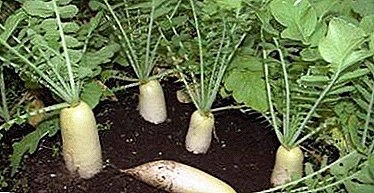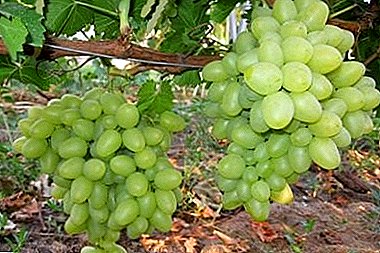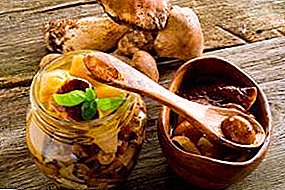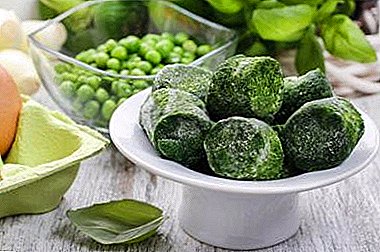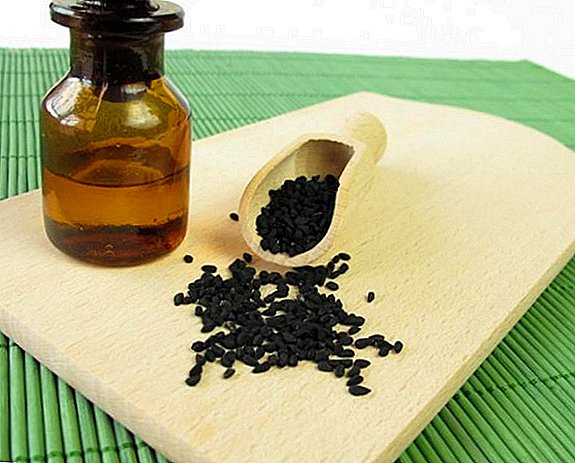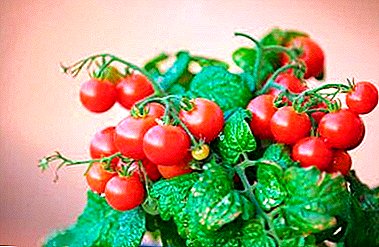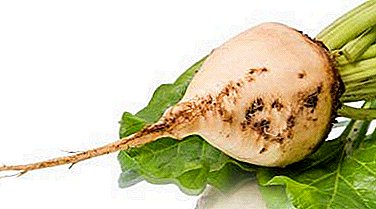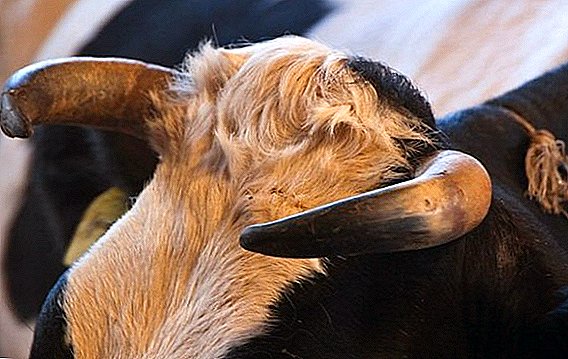 The presence of horns in farm animals is a familiar phenomenon, but it can bring serious trouble.
The presence of horns in farm animals is a familiar phenomenon, but it can bring serious trouble.
For example, an overly vigorous cow often injures its owners, and wounds inflicted by such a “weapon” are very dangerous.
However, before making a radical decision to remove this organ to a cow, it is a good idea to find out why it is needed at all, and whether such an operation would harm the health of the animal.
Why cow horn
At first glance, this kind of "crown" is a weapon with which the beast can defend itself against predators, as well as sort things out with its own kind.  About ten years ago, the magazine Proceedings of the Royal Society B., one of the main publications of the Royal Society of London, published the “sensational” results of recent scientific studies, which confirmed: horns are first and foremost a weapon!
About ten years ago, the magazine Proceedings of the Royal Society B., one of the main publications of the Royal Society of London, published the “sensational” results of recent scientific studies, which confirmed: horns are first and foremost a weapon!
Scientists have carefully studied the anatomical structure of more than a hundred of artiodactyls with horned or hornless females, and concluded that the largest growths on the head are female individuals of those animals that live in open spaces and have maximum sizes.
Such a beast is clearly visible from afar and becomes an easy prey for a predator.
The domestic cow was descended from the now extinct wild bull, which originally dwelt in the steppe zone and had a very impressive size - under two meters at the withers. Thus, the version put forward by scientists fully explains the presence of horns in modern cows.
Did you know? It is believed that of the species of bulls living on the planet today, the African bull ankole-vatusi has the greatest similarity with the ancient wild tour. It is interesting that this animal has the largest horns: they can reach 3.5 meters in length.
However, another thing becomes clear: from the moment the animal was domesticated, the attack of predators is not threatened, with rare exceptions, and, therefore, the horns are no longer needed by cows. 
Anatomical structure
Horns are a derivative of the skin, just like hair, nails and claws, they are formed by the transformation of its outer layer (epidermis).
Like other bovine mammals, the horns of a bull have a bony core (process of the frontal bone), covered from above, like a sheath or capsule, with keratinized epidermis. The growth of the epidermis covering the horn is carried out from the base and, having formed, this cover does not change throughout the life of the animal.
Another feature of cow horns is that they have the same shape in males and females, just in the chicks this organ is slightly smaller.
The horn capsule itself in the section is the upper keratinous layer (epidermis) and dermis connecting the capsule with the frontal bone. The dermis is permeated with a multitude of blood vessels feeding the epidermis producing the horn capsule and ensuring its growth.
Did you know? One of the feats of Hercules, the cleaning of the Augean stables, was in fact a cleaning of the sheds, since the main inhabitants there were not horses, but several thousand bulls.
Under the dermis there is a small layer of loose connective tissue, covered with mucous membrane, and inside it there is an empty (hollow) horn.  The horn is conventionally divided into three parts:
The horn is conventionally divided into three parts:
- top;
- body;
- root, the base of the horn.
The basis of the horns goes into the soft part - the wax, connecting it with the skin.
The dermis with blood vessels is present only in the two lower parts of the horny growth, the apex is a solid cornified epidermis that can be cut without fear of causing the animal pain, trauma and bleeding.
The newly born calf does not have horns, more precisely, they are in their infancy: at the base of the auricle, two cone-shaped sections can be seen, devoid of hair.
Learn more about the anatomy of a cow, as well as learn about the structure of the eyes and udder.
The growth rate of a full-fledged education on the head depends on how well metabolic processes take place in a young body, however, on average, the increase in cones occurs at a rate of 1 cm per month.
Although during the life of a cow the length of its horns remains unchanged, its appearance can be used to determine the age of the animal. The fact is that seasonal changes in the body's work, in particular, changes in the vitamin composition of food in winter, are reflected on the horn plate in the form of the formation of characteristic rings on it.  Sometimes they are almost invisible, but can be well distinguished. In females, such a ring is always formed after each calving. At the end of recovery after stress (winter avitaminosis or childbirth), the work of the epidermis is activated, and the stratum corneum becomes thicker, and vice versa.
Sometimes they are almost invisible, but can be well distinguished. In females, such a ring is always formed after each calving. At the end of recovery after stress (winter avitaminosis or childbirth), the work of the epidermis is activated, and the stratum corneum becomes thicker, and vice versa.
The cow broke the horn: what to do, how to stop the blood
The presence of a large number of blood vessels on the inside of the horn capsule makes injuries to this organ dangerous and very painful for the animal. And such injuries happen quite often, for example, due to a blow, an unsuccessful fall, damage to a leash, pinching between different objects of the horny process can break at different heights or crack.
Among the possible damage should also mention the tearing of the horn capsule or its separation from the horny process.
Important! According to statistics, most of the physical damage that cows get is associated with horn strikes. Due to such injuries, the overall productivity of the farm is significantly reduced, sometimes losses can be up to 10%.
The clinical manifestations of this kind of injury, depending on its nature, may be different, for example:
- If the horn is completely broken, it can hang, holding only on soft tissues and skin. In this case, the animal often has nosebleeds, since the blood released at the fracture site does not flow out, but into the frontal sinus, falling into the nasal cavity.
- If the cornea cover is only partially damaged, the horn may stagger like a bad tooth, causing great suffering to the animal. Such a trauma is also accompanied by internal bleeding and blood can pass through the nose.
- Sometimes a crack is noticeable by damage to the skin or tissue at the base of the horn around the circumference. Such wounds can become inflamed and fester strongly, and the barely retaining horny cover can be easily removed from the bone process.
- Finally, a peculiar form of damage to the horn is its abnormal growth, when, the horn plate begins to develop into the skin or soft tissues, injuring them.
 First aid for such injuries is to stop bleeding and disinfect the wound. The area of damaged skin should be washed, remove dirt and dried blood from it, apply an antiseptic bandage and fix it, attaching it to a healthy horn.
First aid for such injuries is to stop bleeding and disinfect the wound. The area of damaged skin should be washed, remove dirt and dried blood from it, apply an antiseptic bandage and fix it, attaching it to a healthy horn.Important! The closer to the top the horn breaks, the safer the injury is considered and the more favorable its forecast.
If we are talking about a crack, and not a fracture, the horn cover can be saved by overlaying a fixing splint or a plaster cast.
However, in cases of a broken horn at the base, a serious operation is necessary: the broken organ is amputated, the broken bones are leveled with special surgical instruments, then gauze tampons moistened in furatsilin solution are applied to the wound, and the disinfectant bandage is applied.
This bandage changes periodically until the wound is completely healed, sometimes it takes a month or more.
A broken horn case cannot settle down in the same place, therefore, with this kind of injury, the detached capsule is removed, and a disinfecting bandage is applied to the exposed bone process after it is cleaned of dirt, which is periodically replaced until the process is covered with a new cornified layer.  The ingrown horns of cows are treated by removing the wrongly growing tip with a special hacksaw or scissors.
The ingrown horns of cows are treated by removing the wrongly growing tip with a special hacksaw or scissors.
In order for cows not to break their horns, you should pay maximum attention to safety when keeping a herd, in particular, it is very important to properly bind animals, not to allow other objects to be touched with each other’s heads, be careful when putting the cow on its side (for example, ).
However, there are other, more radical ways to prevent injury to the horns of cows, for example, the removal of these become unnecessary organs, as well as the breeding of rocks that initially lacked the characteristic decoration on the head.
Removing horns from cows
Indeed, in almost the entire civilized world today, the horns of cows are removed even in childhood.
Did you know? The cows are well developed ear and musical memory. For example, they can be taught to return from pasture according to a certain melody or sound.
This procedure has become so commonplace that, as confirmed by studies, most American schoolchildren today are not aware that the cow is a horned animal.
Early removal of horns has not only an aesthetic and “traumatic exclusion”, but also a completely pragmatic goal.  It is proved that the formation of cornified growths on the heads requires the expenditure of calcium, phosphorus, selenium and other elements important for the organism of the animal, while the timely deprivation of the calf of this organ directs all the necessary nutrients to the formation of its skeleton.
It is proved that the formation of cornified growths on the heads requires the expenditure of calcium, phosphorus, selenium and other elements important for the organism of the animal, while the timely deprivation of the calf of this organ directs all the necessary nutrients to the formation of its skeleton.
There are several ways of humanely depriving a cow of her “headdress” (this procedure has the scientific name “decornation”, and sometimes is called dehydration in everyday life) - mechanical, chemical, electrical, etc.
It is believed that it is best to carry out the procedure at children's age, when the calf is only beginning to show small horns. With the help of various tricks they simply are not allowed to grow, which minimizes both physical and mental trauma of the animal.
How to saw off
Degeneration of an adult cow, as a rule, is carried out by means of mechanical cutting, that is, the so-called bloody way. There are two possible options - complete amputation or careful cutting of the top.
The first is made exclusively by a veterinarian with the adoption of all necessary measures to anesthetize and prevent severe bleeding, the second can be carried out at home.
For the partial deforestation of adult animals, a hacksaw (Bulgarian) or a band saw is used, the calf can be “treated” with any metal object with a sharp end.  Cutting is done on the same principle as cutting nails: you can cut only the part where there are no blood vessels, that is, literally 5-6 cm.
Cutting is done on the same principle as cutting nails: you can cut only the part where there are no blood vessels, that is, literally 5-6 cm.
Important! Before the procedure, you need to do three things: try to reassure the animal as much as possible, treat the surface with local anesthesia and fix the "patient" head well, otherwise the cow can break the instrument, injure itself or the owner.
If there is still bleeding during the operation, the damaged area should still be removed to the end, and a tight disinfecting bandage should be applied to the wound, attaching it to the healthy horn with an "eight".
The optimal time for the procedure, if we are talking about an adult animal - the off-season, when it is not too cold and not too hot. Decorning is a serious stress for the cow, so during pregnancy, especially in the second half of it, this procedure should not be carried out.
Top cutting is the most common way for adult animals to be insecure. Extremely rarely, they resorted to the complete removal of horns, unless in those cases when a cow shows too active vigor.
Another way to bloodless (but not painless) decornation is to forcibly stop the growth of horns by laying a vacuum rubber ring on their base.  Squeezing tissue leads to the fact that blood stops flowing into the horn, and it is rejected. Usually, this dying off of an organ takes 4 to 7 weeks, and all this time the animal must be under the influence of specially selected local anesthesia.
Squeezing tissue leads to the fact that blood stops flowing into the horn, and it is rejected. Usually, this dying off of an organ takes 4 to 7 weeks, and all this time the animal must be under the influence of specially selected local anesthesia.
After the dressing is removed, if the procedure is carried out correctly, the inlet (cavity), from which the horns grew, tightens the connective tissue, and further any infection in this area no longer occurs.
Chemical removal
Chemically, the horns are removed to calves aged from 3 days to 3 weeks. Actually, no horns, as has been said, the animal at this age yet, so the removal procedure would be not quite correct.
At a later age, chemical treatment can lead to inflammation, bleeding and other adverse effects on the health of the animal.
Important! The calf's horns erupt at about two months of age, the chemical and electrical decorunation methods prevent their growth, so as not to resort to cutting.
For chemical dehydration, the keratinized surface around the buds of the horns is gently cleaned and the wool is shaved at this site.  The skin nearby should be smeared with a generous layer of petroleum jelly, heavy cream, or other protective substance that prevents the used substance from getting into this area that could cause a burn.
The skin nearby should be smeared with a generous layer of petroleum jelly, heavy cream, or other protective substance that prevents the used substance from getting into this area that could cause a burn.
Then the tubercle is treated with a special chemical solution and sealed with a plaster.
As substances that stop the growth of the horny plate, are used:
- potassium hydroxide;
- sodium hydroxide;
- hydrochloric acid;
- Nitric acid;
- a liquid nitrogen;
- caustic based ointment or paste.
Despite its apparent simplicity, the chemical method of dehydration is quite painful, and errors in its use can lead to the fact that the calf completely loses sight.
Electric
Electrical degradation has several advantages over chemical degradation, since it:
- can be performed on older animals, which minimizes stress and gives the farmer more time for maneuver. The optimal calf age when using this method is 20-45 days, but it is possible to carry out treatment at 2 months of age;
- it is performed very quickly: the procedure lasts less than 5 seconds, thus, pain is minimized;
- does not lead to injuries and other negative consequences, healing takes place rather quickly.
 The procedure is carried out with the help of a special device called an electro-thermocauter.
The procedure is carried out with the help of a special device called an electro-thermocauter.Important! Do not feel sorry for the calf, choosing a lower temperature treatment: in this case, the animal receives a burn and is experiencing the same pain, but the procedure does not work, and the horns continue to grow.
It can be easily purchased in specialized stores or ordered online (the price starts from $ 50).
The essence of the electric deforestation is to cauterize the emerging horns with a very high temperature, approximately +1000 ° С, as a result of which their further growth is blocked.
Properly done cauterization leaves in place of the emerging horns dried skin, which itself falls off after a couple of weeks and does not require additional treatment.
Breeds of cows without horns (komoly)
But the most humane way to solve the problem of a bodily cow is to choose a breed that was initially devoid of horns. Such animals are called komolymi and are specially bred so that, without resorting to decornation, they don’t worry about possible injuries that the cattle often inflict on themselves and their relatives.
Learn how to wean a cow butt.
Here are just a few examples of the most popular komolov cows in the world:
- Aberdeen-Angus. It is a descendant of Scottish hornless cows. Direction of use - meat (the breed gives a very valuable marble meat). Slaughter meat yield - up to 70%. Growth in withers - 1.5 m, weight - 0.5 tons in heifers and up to 1 ton - in bulls. A distinctive feature - fine-bonedness with a muscular physique. The suit is black. Very hardy, well suited for breeding in the northern regions with a cold climate.
- Russian Komoly. It was bred in 2007 by Stavropol and Volgograd breeders who crossed the Kalmyk and Aberdeen-Angus breeds of cows. Direction of use - meat (slaughter meat yield - up to 80%). The animal is rather large, its weight at withers reaches 1.45 m, its weight is 0.9-1.3 tons in bulls and 0.8-1 tons in chicks. Color - black, physique - proportional.
- Redpol. English breed of the dairy and meat direction.
Cows include Simmental, Bestuzhev, Caucasian, Sychevsk, Schwyz, Krasnogorbatov cows.
Gives up to 5 tons of very fat milk during the season, slaughter meat output - up to 60%. The weight of a bull is 0.9 tons, calves - 0.8 tons, height at withers - 1.2 meters. The color is red. Body features - long legs, small head and rounded, as if surprised eyes. Poor tolerates dry climate, but at high humidity quite unpretentious.
- Cow from iowa (decorative komoly, or plush). Bred in the USA in 2013. The constitution is stocky. A distinctive feature is a long and delicate coat. The head is small, the neck is short. In addition to the horns, there is also no noticeable udder. Варианты окраса: чёрный, чёрный с белым, светло-коричневый, светло-коричневый с белым, красно-коричневый.The height at the withers is up to 1.35 m, the weight of the calf is usually 0.5 tons, while the bulls reach 0.8 tons. The cost is up to $ 5,000.



 At home, keeping the horns of a cow is not needed. Moreover, this kind of atavism can bring a lot of inconvenience to both the animal itself, and its relatives and owners. For this reason, in many countries, farmers have long been on the path to removing the horny processes of calves at an early age.
At home, keeping the horns of a cow is not needed. Moreover, this kind of atavism can bring a lot of inconvenience to both the animal itself, and its relatives and owners. For this reason, in many countries, farmers have long been on the path to removing the horny processes of calves at an early age.We have not yet taken this procedure, far more often peasants simply cut off the horns of adult cows. However, the most humane and convenient way of dealing with unnecessary and inconvenient growths on the heads of farm animals is breeding of species that are initially deprived of them.


